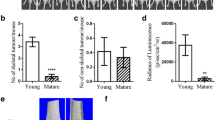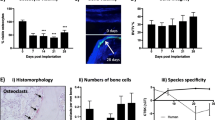Abstract
The Arguello model of cancer metastasis to bone has been used extensively to study breast cancer-induced osteolytic disease. The effects of therapy on skeletal disease and on tumour burden in soft organs are traditionally measured using radiography and/or time-consuming histomorphometry, respectively. The purpose of this study was to develop a sensitive and efficient method for evaluating tumour burden in vivo using MDA-231 cells transduced with the E. coli lacZ gene (MDA-231BAG). Osteolysis was measured by radiography and tumour burden was measured histomorphometrically or biochemically. In untreated mice, measurements of tumour burden in bone extracts using human cytokeratin-associated tissue polypeptide antigen (TPA) ELISA or E. coli β-galactosidase (β-gal) activity immunoassay reflected the extent of osteolytic disease as measured by radiography; however, tumour load could be detected before onset of osteolysis. When monitoring the effect of therapy (0.2 mg/kg ibandronate/day), radiography alone proved to be insufficient. Mice treated with the bisphosphonate ibandronate from time of inoculation with cancer cells had no radiologically visible signs of osteolysis but significant tumour load was measured in the bone extracts using these assays. Furthermore, β-gal activity could be used as a measurement of tumour load in soft organs, and unlike other human breast cancer markers expressed by the MDA-231 cells in vitro, β-gal activity was detected in the serum of mice with progressive disease. In conclusion, we describe an efficient model of breast cancer-induced osteolysis to quantify the effect of therapy on disease load and distribution, which could be beneficial in evaluating novel therapies for the treatment of the disease.
Similar content being viewed by others
References
Arguello F, Baggs RB, Frantz CN. A murine model of experimental metastasis to bone and bone marrow. Cancer Res 1988; 48: 6876–81.
Yoneda T, Sasaki A, Mundy GR. Osteolytic bone metastasis in breast cancer. Breast Cancer Res Treat 1994; 32: 73–84.
Sasaki A, Boyce, BF, Story B et al. Bisphosphonate risedronate reduces metastatic human breast cancer burden in bone in nude mice. Cancer Res 1995; 55: 3551–7.
Guise TA, Yin JJ, Taylor VSD et al. Evidence for a causal role of parathyroid hormone-related protein in the pathogenesis of human breast cancer-mediated osteolysis. J Clin Invest1996; 98: 1544–9.
Mbalaviele G, Dunstan CR, Sasaki A et al. E-cadherin expression in human breast cancer cells suppresses the development of osteolytic bone metastases in an experimental metastasis model. Cancer Res 1996; 56: 4063–70.
Yoneda T, Sasaki A, Dunstan C et al. Inhibition of osteolytic bone metastasis of breast cancer by combined treatment with the bisphosphonate ibandronate and tissue inhibitor of the matrix metalloproteinase-2. J Clin Invest 1997; 99: 2509–17.
Sasaki A, Alcalde RE, Nishiyama A et al. Angiogenesis inhibitor TNP-470 inhibits human breast cancer osteolytic bone metastasis in nude mice through the reduction of bone resorption. Cancer Res 1998; 58: 462–7.
Sasaki A, Kitamura K, Alcalde RE et al. Effect of a newly developed bisphosphonate YH529 on osteolytic bone metastases in nude mice. Int J Cancer 1998; 77:279–85.
Yin JJ, Selander K, Chirgwin JM et al. TGF-? signaling blockade inhibits PTHrP secretion by breast cancer cells and bone metastases development. J Clin Invest 1999;103: 197–206.
El Abdaimi K, Dion N, Papavasiliou V et al. The vitamin D analogue EB 1089 prevents skeletal metastasis and prolongs survival time in nude mice transplanted with human breast cancer cells. Cancer Res 2000; 60:4412–8.
Mundy GR, Yoneda T, Hiraga T Preclinical studies with zoledronic acid and other bisphosphonates: Impact on the bone microenvironment. Semin Oncol 2001; 28: 35–44.
Morony S, Capparelli C, Sarosi I et al. Osteoprotegerin inhibits osteolysis and decreases skeletal tumour burden in syngeneic and nude mouse models of experimental bone metastasis. Cancer Res 2001; 61: 4432–36.
Lee J, Weber M, Mejia S et al. A matrix metalloproteinase inhibitor, batimastat, retards the development of osteolytic bone metastases by MDA-MB-231 human breast cancer cells in Balb C nu/nu mice. Eur J Cancer 2001; 37: 106–13.
Duivenvoorden WC, Popovic SV, Lhotak S et al. Doxycycline decreases tumour burden in a bone metastasis model of human breast cancer. Cancer Res 2002; 62: 1588–91.
Weber MH, Lee J, Orr FW. The effect of Neovastat (AE-941) on an experimental metastatic bone tumour model. Int J Oncol 2002; 20: 299–303.
Winding B, NicAmhlaoibh R, Misander H et al. Synthetic matrix metalloproteinase inhibitors inhibit growth of established breast cancer osteolytic lesions and prolong survival in mice. Clin Cancer Res 2002; 8: 1932–9.
Iwasaki T, Mukai M, Tsujimura T et al. Ipriflavone inhibits osteolytic bone metastasis of human breast cancer cells in a nude mouse model. Int J Cancer 2002; 100: 381–7.
Kruger A, Soeltl R, Sopov I et al. Hydroxamate-type matrix metalloproteinase inhibitor batimastat promotes liver metastasis. Cancer Res 2001; 61: 1272–5.
Sung V, Cattell DA, Bueno JM et al. Human breast cancer cell metastasis to long bone and soft organs of nude mice: A quantitative assay. Clin Exp Metast 1997; 15: 173–83.
van der Pluijm G, Sijmons B, Vloedgraven H et al. Monitoring metastatic behavior of human tumour cells in mice with species-specific polymerase chain reaction: Elevated expression of angiogenesis and bone resorption stimulators by breast cancer in bone metastases. J Bone Miner Res 2001; 16: 1077–91.
Peyruchaud O, Winding B, Pecheur I et al. Early detection of bone metastases in a murine model using fluorescent human breast cancer cells: Application to the use of the bisphosphonate zoledronic acid in the treatment of osteolytic lesions. J Bone Miner Res 2001; 16: 2027–34.
Yang M, Baranov E, Jiang P et al. Whole-body optical imaging of green fluorescent protein-expressing tumours and metastases. PNAS 2000; 97: 1206–11.
Yang M, Baranov E, Wang JW et al. Direct external imaging of nascent cancer, tumour progression, angiogenesis, and metastasis on internal organs in the fluorescent orthotopic model. PNAS 2002; 99: 3824–9.
Wetterwald A, van der Pluijm G, Que I et al. Optical imaging of cancer metastasis to bone marrow: A mouse model of minimal residual disease. Am J Pathol 2002; 160: 1143–53.
Bast Jr RC, Ravdin P, Hayes DF et al. 2000 update of recommendations for the use of tumour markers in breast and colorectal cancer: clinical practice guidelines of the American Society of Clinical Oncology.J Clin Oncol2001; 19: 1865–78.
Holst-Hansen C, Stephens RW, Johannessen BE et al. Plasma Escherichia coli ?-galactosidase as a marker of tumour burden and response to experimental anti-neoplastic therapy in nude mice xenografted with lacZ transduced human tumour cells. Lab Invest2000; 80: 719–24.
Brünner N, Thompson EW, Spang-Thomsen M et al. lacZ transduced human breast cancer xenografts as an in vivo model for the study of invasion and metastasis. Eur J Cancer 1992; 28A: 1989–95.
Hiraga T, Williams PJ, Mundy GR, Yoneda T. The bisphosphonate ibandronate promotes apoptosis in MDA-MB-231 human breast cancer cells in bone metastases. Cancer Res 2001; 61: 4418–24.
Scheven BA, Wassenaar AM, Kawilarang-de Haas EW, Nijweide PJ. Direct and indirect radiation effects on osteoclast formation in vitro. Bone Miner 1987; 2: 291–300.
Holst-Hansen C, Brunner N, Johannessen BE et al. A new immunocapture assay for Escherichia coli ?-galactosidase for in vivo studies of lacZ-transduced tumour cells. Lab Invest 1998; 78: 1643–4.
van Dalen A. Significance of cytokeratin markers TPA, TPA (cyk), TPS and CYFRA 21.1 in metastatic disease. Anticancer Res 1996; 16: 2345–9.
Dittadi R, Coradini D et al. Tissue polypeptide antigen as a putative indicator of apoptosis. Clin Chem 1998; 44: 2002–3.
Gion M, Boracchi P, Dittadi R et al. Quantitative measurement of soluble cytokeratin fragments in tissue cytosol of 599 node negative breast cancer patients: A prognostic marker possibly associated with apoptosis. Breast Cancer Res Treat 2000; 59: 211–21.
van der Pluijm G, Sijmons B, Que I et al. Monitoring progression of breast cancer cells in bone/bone marrow by optical imaging: bisphosphonates do not suppress tumour growth rate and tumour burden. J Bone Miner Res 2002; 17S1: S147.
El-Abdaimi K, Ste-Marie LG, Papavasiliou V et al. Pamidronate prevents the development of skeletal metastasis in nude mice transplanted with human breast cancer cells by reducing tumour burden within bone. Int J Oncol 2003; 22: 883–90.
Ravn P. Bisphosphonates for prevention of postmenopausal osteoporosis. Dan Med Bull 2002; 49: 1–18.
Weiss L Comments on hematogenous metastatic patterns in humans as revealed by autopsy. Clin Exp Metast 1992; 10: 191–9.
Yoneda T, Michigami T, Yi B et al. Actions of bisphosphonate on bone metastasis in animal models of breast carcinoma. Cancer 2000; 88: 2979–88.
Segal-Eiras A, Croce MV. Breast cancer associated mucin: A review. Allergol Immunopathol 1997; 25: 176–81.
Dent GA, Civalier CJ, Brecher ME, Bentley SA. MUC1 expression in hematopoietic tissues. Am J Clin Pathol 1999; 111: 741–7.
Author information
Authors and Affiliations
Corresponding author
Rights and permissions
About this article
Cite this article
Nic Amhlaoibh, R., Hoegh-Andersen, P., Brünner, N. et al. Measurement of tumor load and distribution in a model of cancer-induced osteolysis: A necessary precaution when testing novel anti-resorptive therapies. Clin Exp Metastasis 21, 65–74 (2004). https://doi.org/10.1023/B:CLIN.0000017205.49933.fe
Issue Date:
DOI: https://doi.org/10.1023/B:CLIN.0000017205.49933.fe




